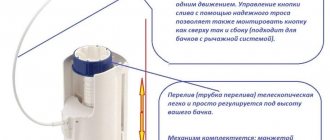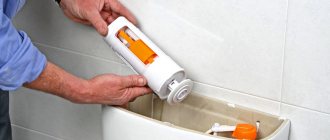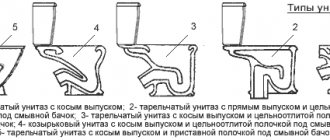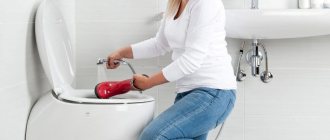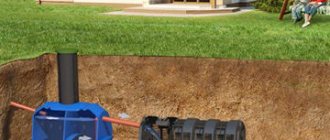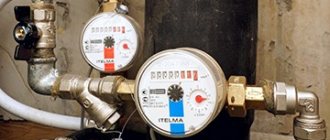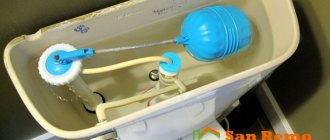I don’t want to imagine comfortable living conditions without such a plumbing fixture as a toilet. In order for it to function normally, the property owner must know its design features.
No matter what the toilet looks like, the filling in the cistern will be similar
Device diagram
This device appeared quite a long time ago; it was used several centuries ago, but then it did not become popular due to the lack of water supply and sewerage systems. The design of a modern toilet is much more complex than that of its predecessor.
The device consists of a bowl, a tank, shut-off valves and a drain assembly designed to release water (read: “Shut-off valves for the toilet - selection and rules for replacing the valves of the tank for draining water in the toilet”). The diagram shows how the toilet is structured in section - in the upper part of its bowl there is a seat with a lid. The device has a simple design, but there are certain nuances regarding the operation of the drain.
Plumbing tricks for convenience and comfort
Wanting to achieve greater comfort, people invent new devices that can improve their lives, eliminating the slightest moments that can cause irritation. For example, many people are annoyed by a falling toilet lid. That is, not even the fact of falling, but the sound that is made.
In this regard, a toilet lid microlift was invented not long ago. This mechanism has recently become increasingly popular and is gaining new fans. It allows you to eliminate the problem described above - the sound of a falling toilet lid. The microlift is not only silent, but also allows the lid to lower smoothly, without sudden movements. There is no need to control this process, which is also very convenient.
Thus, we examined the mechanism of operation of such an important piece of plumbing as the toilet. We learned how water is drained and plunged a little into the world of modern plumbing with its new products.
Principle of operation
The working process is carried out in the drain tank. It consists of a device for filling the tank and a mechanism for flushing water into the toilet. It enters the container through a special hose from the water supply network. To ensure that the liquid is in the tank in the required volume, a filling device is used. When the amount of water in the tank reaches a predetermined level, the shut-off valve stops flowing.
After a person presses the button, the flush mechanism of the toilet tank is activated. The liquid from the container enters the bowl in portions; it has a high movement speed, so it can quickly and efficiently send sewage into the sewer network.
Few consumers are familiar with the structure of the toilet cistern, but the performance of the entire structure depends on its correct settings.
Liquid can be supplied to the device in different ways:
- above;
- below.
Feeding from above is carried out as follows. There is a shut-off valve at the top of the tank, but water enters it from a side channel. There is a float on the inner section of the lever. When the liquid in the reservoir reaches the required level, this element rises.
The rod is now pressed by another lever, as a result of which the valve is pressed and the hole is closed. This toilet structure is the most common. It is mounted on many plumbing fixtures.
If the design provides for a bottom supply of liquid to the device, then the drain fittings are located at the bottom of the tank. When using the equipment, the float moves vertically relative to the direction of the rod.
As a result of its movement, a shut-off membrane is activated, which is used to regulate the level of liquid inside the container. The advantage of bottom feed products is their quiet operation.
Communications
The drain tank is connected to the water supply using a rubber hose. They are equipped with O-rings and have brass nuts. This is the best variant. It is not recommended to use plastic pipes and similar nuts to connect communications. The design will be too flimsy and unreliable. Such products can be put into operation, but only as a temporary option.
The pipe is fixed on the side or bottom of the tank - it all depends on which side the cold water will be supplied from for draining. The lower mounting option is more preferable, since the process of filling the tank in this case is very quiet. And visually this design looks neater.
Tank filling process
In the case where the supply hose is located on the side in the toilet tank diagram, the water level is adjusted by changing the parameter of the spoke, which has a float at the end. Sometimes toilet models use thick brass wire instead of a knitting needle. The higher the float, the greater the volume of liquid will enter the tank.
Plumbing manufacturers are increasingly replacing metal elements with plastic products. But it is impossible to bend them, as they will break. In this case, the toilet flush cistern design provides for the float to move up or down along the pin, as a result of which the volume of liquid changes up or down.
In some designs, to simplify level adjustment, there is a threaded rod used to change the location of the displacer. If the liquid is supplied from below, the float rod is located vertically. The water level can then be adjusted independently. To do this, the float is moved to the lower mark and its position is fixed on both sides with special nuts.
When carrying out this work, you need to remove the lid with the attached button from the tank. In some devices it is rigidly connected to the flush valve. To prevent damage, the design of the toilet cistern with a button must be disassembled as carefully as possible.
First, unscrew the clamp on the button and only then remove the cover. When the float is on top, but does not block the water flow, the malfunction has arisen as a result of incorrect operation of the inlet valve. This part is disassembled, cleaned and put back together or a new one is purchased.
pros
The advantages of toilets depend on the method of their installation, water supply and sewerage. The last two parameters determine the need for additional pipes, fittings and adapters. Sometimes in rooms with complex geometry, a set of adapters and extensions is comparable in cost to the cost of the toilet itself.
More joints mean more weak points that are susceptible to breakage and leaks. Therefore, the advantage remains with options that require a minimum set of fittings.
With tank:
- quick access to communications docking points for maintenance;
- installation does not require renovation of the premises or installation of frames;
- stability regardless of the weight of the person sitting, the plumbing is reliable;
Without tank floor:
- free from the disadvantages of compact systems, aesthetically pleasing;
- unpretentious in maintenance.
Without tank suspended:
- unsightly details are hidden from prying eyes;
- technological niches and frames often do not eat up the entire space - functional cabinets or shelves are created on their basis;
- open floor - easy to clean, no debris accumulates.
Drain mechanism
When it is necessary to wash away sewage, the user presses the button, and then everything happens without his participation. When pressed, the flush mechanism for the toilet tank is activated, the drain valve opens and water leaves the container. Streams of liquid enter the bowl and, after washing away the sewage, are sent to the sewer.
In any plumbing fixture, the filling device and the flush mechanism for the toilet tank are interconnected, although these units are completely different. This means that when you press the button, water begins to flow out and at the same time the tank is refilled, without the need to perform special actions.
There are models in which the toilet flush mechanism is activated using a rope (chain) or lever that must be pulled. Water drainage systems differ in assembly. If they break, you need to purchase a new product and install it.
A simple and long-used design of a drain siphon is a pear, shaped like a plunger. The mass of water presses it against the hole and thereby blocks the drain.
When a person presses the toilet flush lever, the bulb rises to the top and thereby releases water from the hole. The flow of liquid immediately turns on, the pear weighs more and, due to gravity, returns to the saddle.
The toilet flush cistern has an overflow tube that is constantly open, and its upper end rises above the water at a certain distance. If the tank overfills, excess liquid begins to flow into the sewer network.
Wall hung toilets
Scheme of the structure and connection of the toilet.
Suspended devices have become widespread in Europe. In the last 10 years, such suspended structures have become very popular in our country.
The advantage of such a device is:
- easy care;
- high hygiene.
Due to the fact that the toilet bowl does not have a support, it has become very easy to clean the floor of such a toilet. The flush tank is hidden in the wall and is almost invisible. However, this design requires the installation of a supporting frame, which must have a rigid metal frame.
The frame is secured to the floor with anchor bolts. For higher reliability, if possible, it is additionally attached to the wall. This design can withstand 400 kg.
A toilet bowl is installed on the frame, together with a flush cistern. The entire structure is covered with plasterboard sheets. Only the toilet and the flush button remain visible.
Main parts of the toilet:
- Cistern.
- Bowl.
- Seat.
The main part of the bowl is the hydraulic valve. This is a crooked channel that is always filled with water. Its operation allows wastewater to go into the sewer. Such a siphon does not allow bad odors to pass through and blocks blockages.
Features of the dual-mode drain design
In modern models, the buttons on the toilet have two keys; by pressing one of them, you can use water sparingly.
A similar toilet flush device operates in two modes:
- Standard
. In this case, all liquid from the tank in the amount of 4 - 6 liters is discharged. - Half
. After pressing the drain button, only half the volume of the tank is released.
This design of the device is more economical in terms of water consumption, but it is more difficult to configure and repair. In this case, the number of parts that make up the toilet is greater, which means it will break more often.
In addition to products with two buttons, single-button devices are also sold, in which the amount of liquid ejected is controlled by the force of pressing the button. With a weak impact, half the volume is released, and with a strong impact, the entire tank is released.
Modern material
The bowl is made from a variety of materials:
- glass;
- metal;
- tree;
- plastic.
Step-by-step toilet installation diagram.
However, toilet bowls made from ceramics are most often offered for sale:
- sanitary porcelain;
- sanitaryware
These materials are very difficult to distinguish; sometimes even a professional cannot do it. Their cost is exactly the same. However, sanitary porcelain has more positive qualities:
- porosity;
- absorbs less dirt;
- eliminates odors.
To determine the type of material, you need to look at the catalog in the store. It usually indicates the type of material from which a particular model is made.
Adjusting the amount of water drained
The operating principle of the toilet allows you to independently adjust the flow of liquid into the tank. New fittings are always adjusted so that the water in the tank is at its maximum level.
To change the liquid level in a one-button tank, perform the following steps:
- Using a tap located before the supply hose, shut off the flow of liquid into the tank. If this valve is missing, the cold water in the entire apartment is turned off.
- Press the button to drain the contents of the device.
- Unscrew the drain plug, take the rim by the bolt, and remove it. To avoid breaking the fittings, the lid should not be lifted until the plug is removed.
- Next, lift the lid to look at the water level. He is usually the tallest. There are divisions on the overflow tube - with their help you can find out the level of water discharge.
- They are looking for a float - it is usually connected to a foot for supplying liquid.
- To reduce its flow, tighten the screw on the valve mechanism clockwise.
After completing the adjustment, check the level of fluid rise. Its surface should be located at a distance of 3 centimeters from the overflow tube. When the toilet is working properly, place the lid in place and tighten the button.
Problems
Inconveniences depend on the type of product.
Toilets with tank
- systems of this type are always floor-mounted;
- the space required for the tank is in most cases non-functional;
- inconvenience when cleaning the floor; dust and debris accumulate behind the pedestal, which are difficult to reach.
- unaesthetic - communications in plain sight.
The length of models with a solid cast shelf is at least 605 mm; compact models from 330 mm are inconvenient in everyday life. Combined with the size of the tank, which even in smaller models usually extends beyond the dimensions of the device, the toilet will require at least half a meter of free space.
Without tank
Hanging:
- access to communications is difficult - an inspection hatch is required for major work, the rest is carried out through the hole for the button.
- a steel frame cannot be hidden in a closet - it will require covering with plasterboard or panels, and with it additional costs for finishing materials.
Floor:
- installation requires a niche or frame that masks the drainage system;
- combine the inconvenience of servicing wall-mounted and floor-standing models.
All tankless systems share a common problem - costly installation.
The frame width in hanging models reaches 50 cm. Smaller variations of 35 and 40 cm are less reliable in operation and can withstand less weight. The frame is attached to the floor and base walls of the bathroom.
Strengthening the sheathing frame is often required. It is inappropriate to leave the structure in its original form - it must be protected from moisture and decorated. Labor costs for installation are comparable to a complete renovation of the premises.
Further maintenance of the suspension system in case of breakdowns and leaks requires access through the button cover. The hole is small - it is difficult to work with two hands. Accordingly, tightening and sealing fittings, not to mention replacing parts, will take several times more time than when working with a conventional cistern toilet.
To simplify access, it is customary to leave an inspection hatch in an inconspicuous place behind the toilet. This will speed up access to communications and facilitate maintenance.
Hatches are supplemented with special doors (usually ready-made plastic ones) of the required size. Comfortable for work - the width of two standard wall tiles 15 by 20 cm. As a result, the width of the hatch will be just under 30 cm, taking into account the sides and frame.
We completely change the fittings
If you have no desire to study what exactly is broken in the insides of your cistern, you can simply replace all the components at once. Depending on the type of tank, the fittings inside it are also different, so do not rush to throw away the old design, it can be demonstrated in the store for the safe purchase of a new set. The instructions for dismantling and installation are quite simple:
- First, turn off the water.
- Unscrew the top button and carefully remove the cover. You can put it aside; you will need it at the very end.
- Next, unscrew the connecting pipe and remove the dialing system.
- Disconnect the lever with the drain valve and pull it out.
- After the tank is empty, we begin installing the new fittings in the reverse order - how it was disassembled.
The only tools you will need are pliers and wrenches.
High-quality fittings for drain bull
Possible problems
If water is regularly collected in the tank, then the mechanical valve requires replacement. When the float arm becomes deformed, try to align it, if not, replace it. If problems arise with the float, then this defect occurs from a loss of tightness, since water gets inside and the float stops doing its job.
If water flows at the bottom of the drain tank, then the cause of this breakdown is a crack or rotten bolts. To avoid this problem, change them. This procedure will require editing outdated fasteners and cleaning the landing spots, then installing new bolts. When choosing bolts, choose brass or bronze ones - they are not in danger of rusting.
When water flows into the toilet, you should pay attention to the membrane. Remove the siphon and change it. Often this situation occurs when the float adjustment is lost
The lever does not completely shut off the water, and it enters the toilet through the overflow tube. This problem can be eliminated by adjusting the float. When you adjust the system correctly, it will close the valve at a water level of 1-2 cm
Often this situation occurs when the float adjustment is lost. The lever does not completely shut off the water, and it enters the toilet through the overflow tube. This problem can be eliminated by adjusting the float. When you adjust the system correctly, it will close the valve at a water level of 1-2 cm.
If it is leaking from the side inlet, then most likely the problem is in the hose. When little or no water is drawn in or the process is slow, the inlet valve mechanism has reached the end of its life. In the first case, you need to replace the valve, in the second you need to unscrew the hose and try to clean it. This, of course, is not always possible, since debris may get in, for example, during repairs. In such cases, it is most often changed.
Features of drain fittings for a tank: installation technology and prices
The drain fittings consist of a drain lever and a drain siphon. The main function of the latter is to seal the hole hermetically when the liquid has drained. There are several structural models of siphons. The simplest products look like rubber cylinders.
Average prices for cistern fittings (flushing mechanisms):
| product name | price, rub. |
| Alcaplast toilet fittings | |
| For high tank | 325 |
| For installation "Ecolodge" (height 1000 and 1200 mm) | 450 |
| For low tank | 510 |
| With stop button | 725 |
| With extended stop button | 780 |
| With double button | 980 |
| Geberit fittings for toilets with installation | |
| Name of models with which the mechanism is compatible | price, rub. |
| "Delta" UP100, "Sigma" UP320, "Sigma" UP300 | 1350 |
| "Delta" UP172 | 1400 |
| "Kappa" UP 120 | 1455 |
| "Sigma" UP720 | 1555 |
| "Omega" 12 | 2200 |
| "Delta" UP182 | 2300 |
How to install and adjust a toilet flush
Before starting work, it is advisable to sort all the parts of the kit so that each bolt is accompanied by a gasket and washer. Fastening is carried out as follows: a washer is put on the back of the bolt, followed by a nut, which must be tightened tightly, but very carefully so as not to damage the ceramic coating.
Recommendations for the toilet flush device:
To ensure that the drain mechanism sits tightly, you need to use a rubber gasket.
- Install the drain mechanism in the tank in its designated place.
- In order for the part to fit tightly, you need to use a rubber gasket, which should be placed on the nut.
- Securely fix the mechanism using a plastic nut.
If the sealing part has already been in use, then the connection area must be additionally treated with a sealant (experts do not recommend reusing the sealant). New rings don't need this.
Note! If minor casting defects are found in joint areas and parts, a sealing compound must be used.
To adjust the toilet flush by adjusting its height, you must:
The drain intensity is adjusted by moving the damper or float
- Release the overflow tube.
- Carefully press out the element securing the glass.
- Move the stand vertically until it reaches the desired height.
- The glass should be moved along the guide so that its upper edge does not reach the edge of the drain tank by at least 4.5 cm.
- The placement of the overflow pipe is checked. In the correct position, this element is 7 cm lower than the top of the post and 2 cm above the surface of the water.
To adjust the intensity of the drain, you need to move the damper or float.
Guarantee
Manufacturers' warranties do not cover mechanical damage to the toilet or tank. The use of unsuitable cleaning agents, incorrect installation or operation is also not covered by the warranty.
Manufacturers carry out repairs or replacements only if there are manufacturing defects and defects, so multi-year warranty periods are not an advantage; a minimum of 1 year is sufficient. If the device contains manufacturing defects, they will be identified during this period.
Most manufacturers provide a standard warranty on plumbing fixtures of 3-5 years.
We repair the float and eliminate all types of leaks
Let’s go directly to the guide “how to repair the insides of a toilet cistern.” There can be several consequences of malfunctions, depending on what exactly is broken.
- Water keeps flowing into the toilet. Here the breakdown lies in the float, twist or valve of the shut-off valve. After long-term use, the surface of the float may become covered with cracks or it may simply crack in one place, then when water is collected, it will float up with a delay, and water will constantly be collected. In this case, the float can simply be replaced. Another reason is that the metal twist is bent or the plastic ratchet is cracked, through which the impulse from the float is transmitted to the valve, then the metal can always be straightened, but the plastic will also have to be changed. If the valve does not close, then you can install an additional float valve, since most likely the valve cannot cope with the water pressure.
- The collection of water is accompanied by loud noise. There are two ways to eliminate this defect:
- change the diameter of the hole through which water is poured;
- insert a small tube about 35 cm long into the hole, then water will flow through it and the noise from filling the tank will be significantly reduced.
- The tank leaks directly onto the floor. This means your mounting bolts have rotted. It's very easy to find out.
- Turn off the water completely.
- It is better to scoop out the remaining liquid in the tank with something, or place a container in the place of the leak and flush the water down the toilet.
- Disconnect the flexible hose.
- We disassemble the fasteners that connect the tank and the toilet shelf.
- We remove the tank and put it aside.
- We remove rotten bolts, both of them, regardless of their condition.
- We carefully clean all connecting places from rust and lime deposits.
- Install new bolts.
Toilet cistern
- It is also better to replace the rubber cuff for reliability.
- We put everything in its place.
- We check the functionality.
The malfunction may not always appear immediately, so watch for condensation and leaks over the course of a couple of days.
- A situation arises when water constantly flows into the tank. This means that the water drainage system is faulty in part of the drain valve or the lever itself. This will most likely require replacement. It's quite easy to do this with your own hands.
- remove water from the toilet;
- remove the entire system;
- we change it to a new one;
- fill the tank with water and check for functionality.
Since the entire system is sold assembled, both valve and lever will be replaced at the same time.
- The flexible hose is clogged. It is very simple to check: turn off the water, disconnect the flexible hose, placing it above any container, and slightly open the tap. If water does not flow, the hose is clogged and needs to be replaced. If water flows out, then the problem is not in the hose. We continue the search.
Replacing elements of the flush cistern
- The upward guide may clog the shut-off valve hole. It can be cleaned with a screwdriver.
- If the problem is not in the technical hole, then the valve itself may not work. It can only be replaced; it cannot be repaired.
Main reasons for replacement
All elements of the flush mechanism are interconnected, and the failure of one of them can lead to disruption of the entire system.
After prolonged use of the toilet, the quality of the flush mechanism may decrease due to dirt, hard water and wear of parts. Malfunction of the drain system in the tank occurs for various reasons:
- Constant collection of water and draining its excess mass into the toilet. The float or shut-off valve should be checked. During operation, the plastic float mechanism wears out and cracks, so it will float more slowly than necessary, and water will continuously accumulate - replacement is required.
- Another reason when liquid is continuously collected can be: bending of the metal twist or breakage of the ratchet. The first one can be straightened, but the plastic part needs to be replaced. And if the valve does not work (high water pressure), then install an additional float valve.
- If the liquid does not flow into the drain tank. This happens due to the following factors: A blockage in the flexible hose - you can check by turning off the water, disconnecting this element from the tank, and pointing its end into the toilet. If, after opening the valve, water does not flow, the tube is clogged and needs to be replaced.
- If the hole in the shut-off valve is clogged, it can be cleared using a thick wire or a knitting needle.
- The valve itself is faulty.
Plaque and mucus that accumulate on the shut-off element can also disrupt the tightness of the drain system.
Which is better
The best type of toilet varies from person to person:
- The device should be easy to care for and maintain, harmonize with other equipment and fit into the dimensions of the room without creating inconvenience.
- Ideally, water and sewerage connections should not require the purchase of additional pipes and fittings. In this case, to install the toilet you will only need to fasten and connect the necessary communications.
- Availability of service centers and warranty service points during the first year of operation is a priority.
- Spare parts for devices from little-known manufacturers will be difficult to find if the toilet is different from the standard one.
